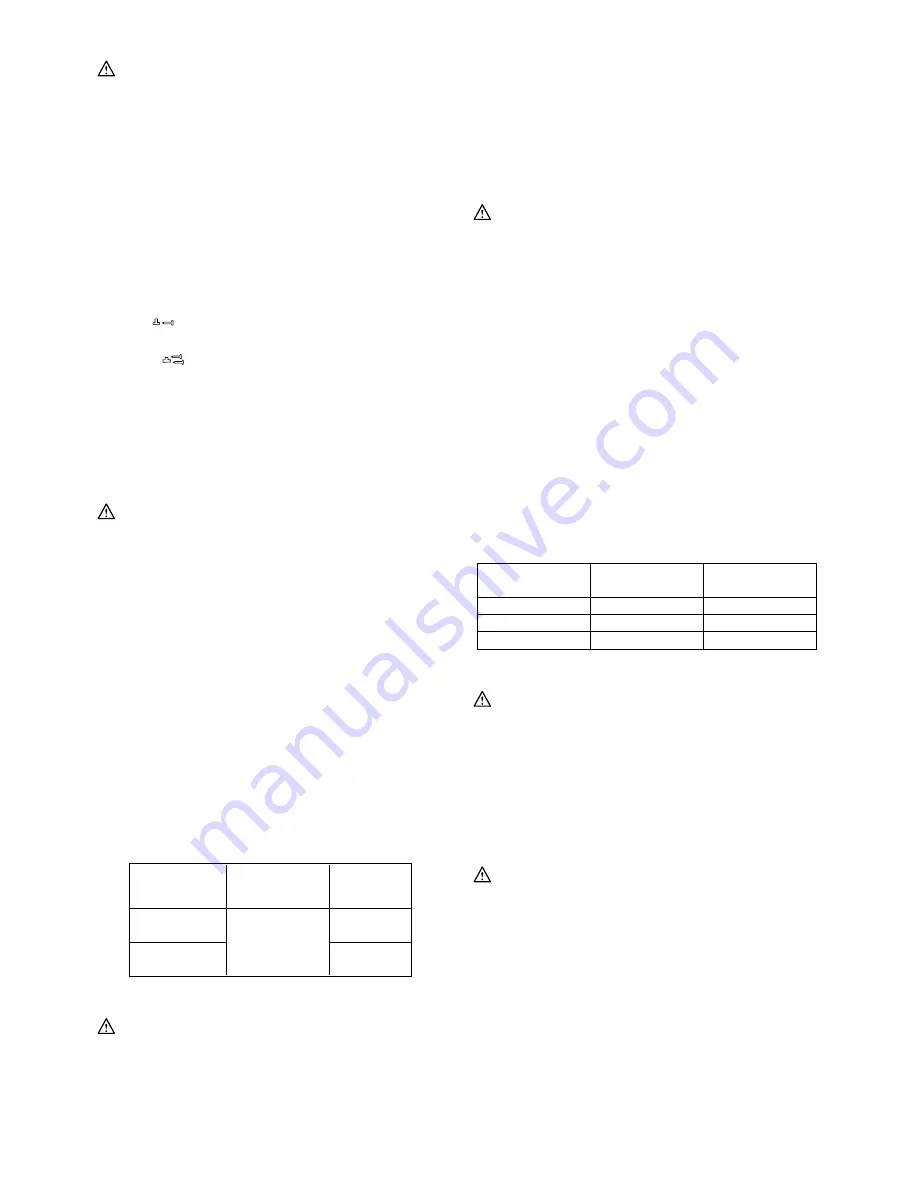
9
CAUTION:
•
However when the tool is set to the "Intermittent
Nailing" mode, WITH THE TRIGGER HELD IN A
HALF-PULLED POSITION, an unexpected nailing
could occur, if contact element is allowed to re-
contact against the workpiece or the other surface
under the influence of recoil.
In order to avoid this unexpected nailing, perform
as follows;
−
A. Do not place the contact element against the
workpiece with excessive force.
−
B. Pull the trigger fully and hold it on for 1-2
seconds after nailing.
•
For No. (1) method, set the change lever to
the
position.
For No. (2) method, set the change lever to
the
position.
After using the change lever to change the nailing
method, always make sure that the change lever
is properly set to the position for the desired
nailing method.
Fig.12
Nailing of steel plate
WARNING:
•
Use 3.2 mm or less steel for C-shaped one.
The tool will bounce severely and a nail struck
back, causing serious injuries.
•
Use hardened nails only for steel plate.
Using other purposed nails may cause serious
injuries.
•
When nailing, hold the tool so that it stands upright
to the driving surface.
Slanted nailing may cause nails to strike back,
causing serious injuries.
•
When fastening a corrugated zinc plate on the C-
shaped steel, use 0.7 mm or less thick plate and
32 mm long hardened nails. Failure to do so may
cause nails to strike back, causing serious injuries.
•
Do not use the tool for nailing on ceiling or roof.
Choose and use nails more than 10 mm longer than
total thickness of all workpiece to be fastened by
referring to the table below.
M
ate
ri
a
l
th
i
c
kn
ess
(mm)
C-
sha
p
ed
stee
l
(mm)
N
a
il l
e
n
gth
(mm)
14 - 35
15 - 40
1.6 - 3.2
45
50
011569
Fig.13
CAUTION:
•
Depending on the hardness and total thickness of
all workpiece in combination to be fastened,
enough fastening may not be obtained. Nailing on
steel plate to excessive depth may extremely
reduce the fastening force. Before nailing, adjust
the nailing depth properly.
•
In the nailing on the steel plate, the driver may be
clogged due to susceptibility to wear. When it is
worn, sharpen it or replace it with a new one.
Nailing of concrete
WARNING:
•
Use hardened nails only for concrete.
Using other purposed nails may cause serious
injuries. Do not nail directly on the concrete or do
not use to fasten directly the steel plate to the
concrete. Failure to do so may cause concrete
fragments to fly off or nails to strike back, causing
serious injuries.
•
When nailing, hold the tool so that it stands upright
to the driving surface.
Slanted nailing may cause concrete fragments to
fly off or nails to strike back, causing serious
injuries.
•
Do not use on the surface that objects hang from,
such as area where hangers for sewer pipe, dust
pipe etc. are set up
Choose and use nails so that the penetration amount
into concrete ranges 10 mm - 15 mm by referring to the
table below.
30
35
45
50
Woo
d
th
i
c
kn
ess
N
a
il l
e
n
gth
(mm)
(mm)
(mm)
Con
c
r
ete
r
a
n
ge
50
65
10 -15
10 -15
10 -15
009480
Fig.14
CAUTION:
•
Use this tool only for soft concrete built up not so
long before. Using on the hard concrete may
cause nail bending or nailing to insufficient depth.
•
When the penetration amount into concrete comes
to more than 15 mm, nailing to the sufficient length
may not be obtained.
Cutting off the sheet
Fig.15
CAUTION:
•
Always disconnect the hose before cutting off the
sheet.
Tear off the output sheet in the direction of the arrow
when using the sheet collated nails.
Summary of Contents for AN911H
Page 3: ...3 1 2 3 13 009481 1 2 3 14 009200 15 009472 16 009477 17 009473 1 18 009193 1 19 004317 ...
Page 61: ...61 ...
Page 62: ...62 ...
Page 63: ...63 ...
Page 64: ...64 Makita Corporation Anjo Aichi Japan www makita com 884847F983 ...





































